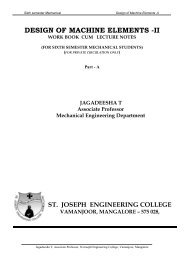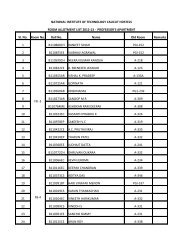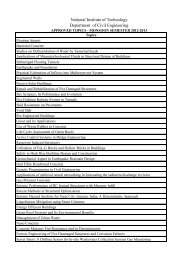COMBUSTION CHAMBERS - National Institute of Technology
COMBUSTION CHAMBERS - National Institute of Technology
COMBUSTION CHAMBERS - National Institute of Technology
Create successful ePaper yourself
Turn your PDF publications into a flip-book with our unique Google optimized e-Paper software.
INTERNAL <strong>COMBUSTION</strong> ENGINES (ELECTIVE) (ME667)SIXTH SEMESTERCylindrical Chamber: This design was attempted in recent diesel engines. This is amodification <strong>of</strong> the cylindrical chamber in the form <strong>of</strong> a truncated cone with base angle<strong>of</strong> 30°. The swirl was produced by masking the valve for nearly 180 0 <strong>of</strong> circumference.Squish can also be varied by varying the depth.Toroidal Chamber: The idea behind this shape is to provide a powerful squish alongwith the air movement, similar to that <strong>of</strong> the familiar smoke ring, within the toroidalchamber. Due to powerful squish the mask needed on inlet valve is small and there isbetter utilisation <strong>of</strong> oxygen. The cone angle <strong>of</strong> spray for this type <strong>of</strong> chamber is 150° to160°.IN DIRECT INJECTION <strong>CHAMBERS</strong> ( VTU Dec 06/Jan 07)A divided combustion chamber is defined as one in which the combustion space isdivided into two or more distinct compartments connected by restricted passages. Thiscreates considerable pressure differences between them during the combustionprocess.( VTU Dec 06/Jan 07)Ricardo’s Swirl Chamber: Swirlchamber consists <strong>of</strong> a spherical-shaped chamber separated fromthe engine cylinder and located inthe cylinder head. Into thischamber, about 50% <strong>of</strong> the air istransferred during the compressionstroke. A throat connects thechamber to the cylinder whichenters the chamber in a tangentialdirection so that the air coming intothis chamber is given a strong rotary movement inside the swirl chamber and aftercombustion, the products rush back into the cylinder through same throat at muchhigher velocity. This causes considerable heat loss to walls <strong>of</strong> the passage which canJagadeesha T, Assistant Pr<strong>of</strong>essor, Department <strong>of</strong> Mechanical Engineering, Adichunchanagiri <strong>Institute</strong> <strong>of</strong> <strong>Technology</strong>, Chikmagalur
















